January
East Falls Past – Henry Avenue Bridge
The Fallser, January 2015, by Wendy Moody
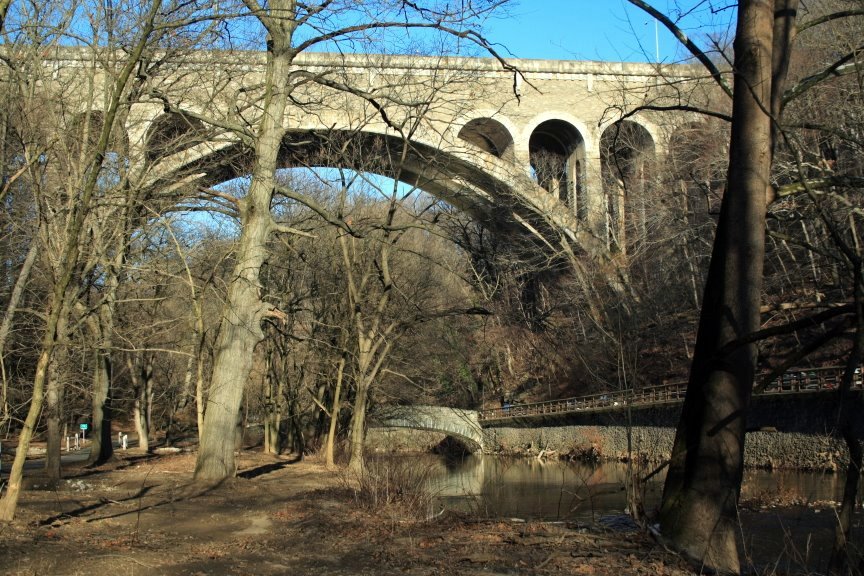
In 1932, the Suburban Press reported on the progress of the new Henry Avenue Bridge and roadway through East Falls. Regarded by city engineers as the most important project ever undertaken in the 21st Ward, the new highway – about two miles long – was said to afford incalculable benefits. The most important of these was to supplant hilly Ridge Avenue (at the time the only direct link between Roxborough and center city) as the main arterial highway.
Planned since 1917 to appease Roxborough for the withdrawal of the high speed traction line in that area, the bridge encountered many obstacles since its inception. Among these was a failure by the city to sell enough municipal bonds to fund the two approaches to the bridge, delaying both contracts and the bridge’s opening.
A more serious obstacle was the possible collapse of the bridge caused by the buckling of the bridge’s steel “falsework.” Emergency work was required. A lawsuit ensued – the contractor, wanting to be paid for this extra work, claimed the buckling was due to modifications to the plan made by city engineers. When the keystone was lowered into the second arch and the concrete set, the bridge was safe since the arch was now held solidly by its own weight.
The project cost city taxpayers over $2,375,500. The principal item in the budget was a $1,770,000 contract limit for the ornate bridge. $62,500 was provided for the two approaches at Walnut Lane and School House Lane. For these, the contractor excavated 47,000 cubic yards of earth and required 71,500 cubic yards of fill.
The bridge was dedicated as Wissahickon Memorial Bridge in tribute to residents in northwest Philadelphia who served in WWI. The name was suggested by veterans and was officially adopted by City Council in 1931, though there was discussion that the name “Wissahickon” (in the 21st Ward) was not inclusive of the bridge’s approach in the 38th Ward (i.e. Falls of Schuylkill).
The bridge is a two-ribbed, open-spandrel, reinforced concrete arch bridge with one principal span. It was designed by Paul Philippe Cret, a nationally acclaimed Philadelphia architect, in collaboration with Frank M. Masters. Several times the Art Jury and Fairmount Park Commission failed to approve the plans and had them redrafted. Ralph Modjeski and Clement E. Chase were the engineers.
The bridge is 333 feet long, with a main span of 288 feet, and a 60-ft-wide road carrying two lanes of traffic in each direction. The roadway is 170 feet above the ground and was designed to accommodate a lower deck for subway cars, which was never built.
The bridge has been known as a suicide bridge since its opening. Beginning in 1941 for an unknown duration of time, a policeman patrolled the span, questioning all pedestrians walking the bridge. Some old photos show netting beneath it.
It was listed on the National Register of Historic Places in 1988.
February
East Falls Past – Gustine Lake
The Fallser, February 2015, by Wendy Moody
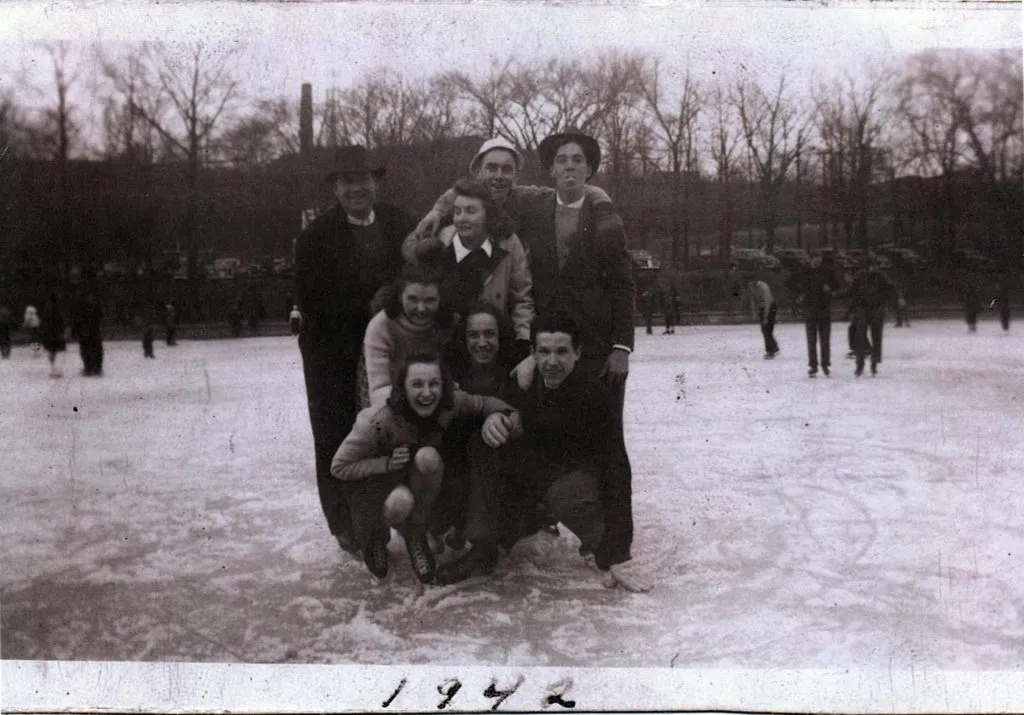
Many Fallsers have shared their childhood memories of Gustine Lake – swimming in the summer, ice skating in winter. This man-made lake, long gone, was located on the 4200 block of Ridge Avenue, near the Wissahickon Falls, east of the base of School House Lane.
Here’s some background on how it came by its unusual name:
When the Committee on Plans and Improvements of the Commissioners of Fairmount Park met in 1901, it appropriated $35,000 for the construction of an artificial lake between the Pumping Station and the Wissahickon Creek to replace an unsightly piece of swampland.
There were many suggestions on what it should be called:
One local historian suggested it should honor George Washington since,according to General Washington’s orders given during the Battle of Germantown, a body of Hessian troops were to be stationed there to defend the mouth of the Wissahickon from attack by colonial forces. Thus, the appellation, “Lake Washington.”
Still another, with the Civil War in mind, recalled the early days of the Rebellion when the tract surrounding the pumping station was used as a camp for the 68th Pennsylvania Volunteers, which included many local soldiers. Since this was known as Camp Cameron, “Lake Cameron” was suggested as a name for the concrete basin.
Another person proposed the name “Lake Meadows” since “the Meadows” was the local name used for the site. This name originated from “Robeson’s Meadow” – the famous Robeson flour mills were once located here. Next to the mill, the Robeson’s built a mansion where James Dobson lived when he started his woolen mills on this site.
The plan of Superintendent Vodges, who was in charge, provided for an attractive lake of five acres of water surface and four feet in depth. The drawings disclosed paths and walks leading to the lake, which was to have a granite coping border and stone steps leading to the water’s edge. The bottom and sides were to be concrete. The plan was approved and carried out in its entirety, though there was thought to substitute cheaper materials.
Judge Thompson, however, who fathered the project, maintained that since it was to be a permanent lake, it should be built to last. Commissioner Pollock, Mayor Stokely, and Charles Henry agreed. They believed the public would approve the expenditure as honest and judicious, since the lake would be accessible to all children of northwestern Philadelphia and would replace an unattractive bit of swampland with a beautiful lake.
Judge Thompson then jocularly suggested: “Let us call the lake Gustine, which is my middle name, and then if the public does not regard it as a thing of beauty that we intend it to be, it can be referred to as “Dis-Gustine.”
Judge Thompson’s little joke provoked laughter at the time, but today it is fondly remembered as “Gustine” with few realizing how it got its name.
(from Suburban Press, 1930)
East Falls Past -World War II Memories
The Fallser, March 2015, by Wendy Moody
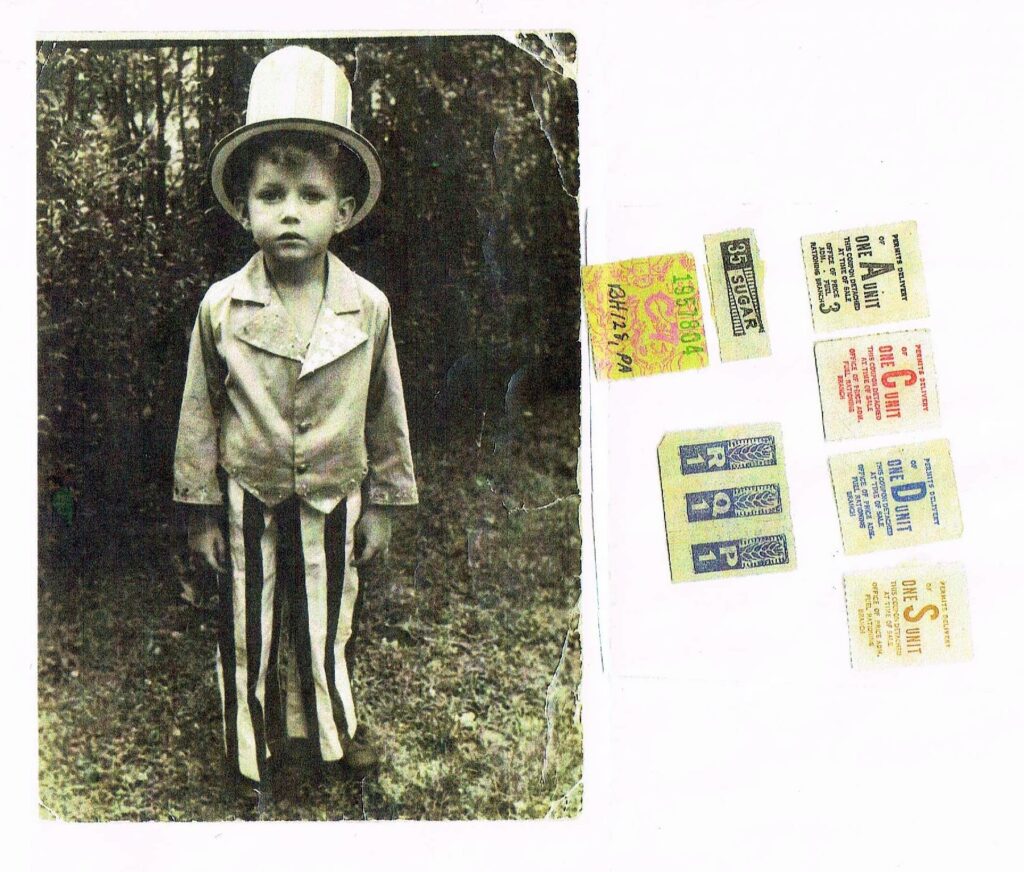
Reminisce with these evocative WWII memories of the East Falls homefront:
Daniel Furman:
- I remember the air raid alerts with sirens going off. Everyone had to be indoors with their lights out and shades down or else you’d get a knock on your door.
- Sometimes, across the street, they unfurled a big flag with a star for each military man on the block. It really pulled us together.
- Wesley Foster, the plumber honchoed the scrap metal drive. The kids got their wagons, knocked on doors, and created a huge pile of metal on Ridge Ave – probably 40’ high, made of everything imaginable…
- I still have my ration book for sugar and butter. My dad had two gas stations in East Falls and rationed gas. There were A, B, C and D stamps – A was a common citizen who got so many gallons, B was maybe a business….and when the government monitor came to read the meters, you better have 2000 stamps collected if you had sold 2000 gallons of gas.
- I remember buying war bond stamps. When you had $18 worth in your book you earned a $25 war bond. Mifflin got involved and when all the students had enough savings bonds to equal the price of a jeep, they brought a jeep to the school and had it go down the steps into the school yard and up again. The school was glad we didn’t have enough for a tank!
Jack McNicholas:
We’d drive 8 hours to go to Atlantic City to get spring water with our rationed gas. I think black coupons were for gas, red for meat.
I can remember all the excitement of VJ Day – people banging pots like it was New Year’s Eve. Then, of course, all the anticipation of the people coming back. My uncle, Tom Lynch, who was the first to go and was oversees three years, was one of the first to return. Some didn’t come back.
Robert Connolly
During WWII, the Army made gas masks at the Atwater Kent buildings on Wissahickon. I know because my mom worked as an inspector of masks. The upper building was used as a Signal Corps repair shop.
Herb Henze
For rationing we had little red fiber tokens with numbers on them and little green stamps in a book. My mom was not big on sugar so she would trade off with the wonderful Irish lady, who took a lot of sugar in her tea. She took our sugar stamps and gave us some meat stamps.
We saved our cans – cleaned them out, stuck the lids inside the tins, flattened them, tied them together, and put them out for recycling with the cardboard.
We even saved bacon fat in a container – they collected that too. I was told they made soap with it.
East Falls Past – Daniel Furman
The Fallser, April 2015, by Wendy Moody
Daniel Furman, one of the interviewees in last month’s column who reminisced about East Falls during WWII, entertains us with more local memories:
- I was born on Halloween in 1935 and lived at 3714 Calumet Street.
- I attended the old Falls Presbyterian Church on Ridge Avenue, before the new church on Vaux was built in 1943. My father was strict – we weren’t supposed to listen to the radio on Sundays. My mother, though, told me to turn the radio on very low on the third floor so I could listen to the ballgames.
- My brother and I walked both ways to Connie Mack stadium on Lehigh Avenue.
- Growing up I worked in my father’s gas stations on Midvale- the Atlantic Station across from Mifflin and one near East River Drive. At age 7 my job was sweeping out the cars before they were washed. Everyone smoked then and it was horrible getting that nicotine off the windows!
- We shopped at the ACME on Ridge Avenue. My brother and I earned tips delivering groceries in our wagon for people who couldn’t carry them home. We also earned 2 cents by putting the poles up and down for the 52 trolley where the line ended at Ridge and Midvale. Sometimes we were lucky and the conductor gave us a nickel.
- We used this money to buy baseballs. Some of our baseballs were repaired with electrical tape so instead of seeing a white baseball coming at you, you’d see this black baseball!
- Calumet was a hilly, cobblestone street. An old guy with a horse drawn wagon bought newspapers we had saved – 500 pounds of them. With the cart loaded, his horse struggled to hold the cart back going down the slippery cobblestones. In winter, we’d spread ashes from our coal stove at the bottom of Calumet to stop skidding onto Ridge.
- The streets had gaslight lampposts and each night a man lit them using a pole and hook. Since we played hide and seek at night, we’d climb the pole to turn them out so it would be dark enough to play and turn them on again before we went in.
- I started rowing around 1948. My dad’s friend Charlie McIlvaine drove me to Vesper Boat Club where I learned to be a coxswain. In 1950 we won the US National Championship in “lightweight fours with coxswain” which meant we could enter the Canadian National Championships. Unfortunately, Canada’s lightweight fours were without coxswain, which meant I couldn’t go. At the dock I asked John B. Kelly Sr. if I could go if I paid my own way. He invited me to ride in his big limousine and gave me $10 in spending money!
Corrections from March column: 1) the last three paragraphs are attributable to Herb Henze.
2) Jack McNicholas got his spring water in Germantown, not Atlantic City. His trips to AC took 8 hours, round trip.
East Falls Past – Grace Kelly Anecdotes
The Fallser, May 2015, by Wendy Moody
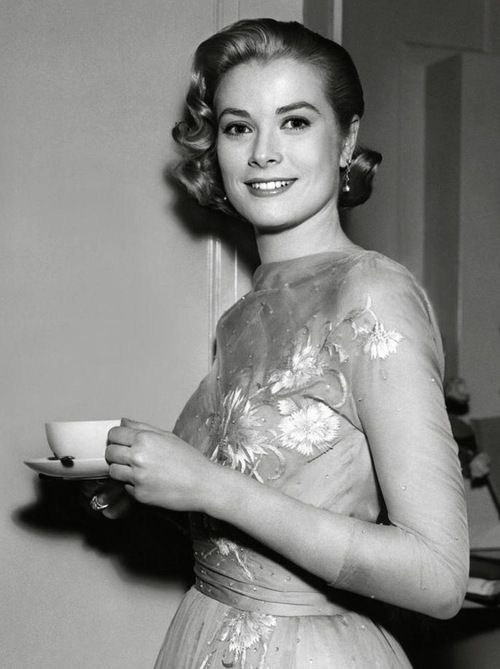
With the opening of the Grace Kelly Gallery, we’re revisiting anecdotes of Grace from earlier columns. Hope you enjoy them a second time!
Paul Costello: “Grace Kelly was my third cousin. We’d swing Grace by her feet and hands on the beach. She didn’t like Jack swinging her because he gripped her fingers too tightly, but I swung her by her ankles and wrists so she couldn’t slip out of my hands. She was the most pleasant person you’d want to talk to, and very attractive!”
Edie Gotwols: “I did three plays with Grace at Old Academy. Grace was a bit on the quiet side and was lovely. Once we were sitting next to the prompter who looked down and said: “Grace, you have runners in your stockings!” and Grace said “My mother makes me wear them.”
Joe Petrone: “Ah! I was in love with Grace. In 1952, her mother was involved with the hospital’s Rose Carnival. I was nine. My job was to ride through East Falls in the back of a Buick convertible with Grace Kelly and sell chances. I’d sit and gawk at her. She was very pretty, a princess. Once at the carnival, Grace donated a gold compact with her name engraved on it. It was $5 but that was a million dollars then… I wanted it so bad, but didn’t get it. “
Harry Prime: “I’d go to mass purposely to sit near Grace. Her father was 6’2, a big guy, and walked in with Margaret and the kids, like the Van Trapp Father. I sat behind them and would say “Good morning Grace” and she’d say good morning. Grace was a striking beauty.”
“When she acted at Old Academy in Craig’s Wife, written by her uncle, I worked at WCAU and was assigned to the show, with Grace as my host. I jumped at that. Her personality was cold and standoffish, but confident.”
Lizanne LeVine: (Grace’s sister): “We helped mother raise money for Medical College’s Spring Fete. The night before the event, after dark, we sent Grace over the fence to steal Old Mosie Brown’s violets and the neighbor’s daffodils. We’d make bouquets, and in the morning sell our neighbors their own flowers!
My first play was The Women at Old Academy – I took over for Grace when she got the measles. At dress rehearsal, mother said “Gracie, you look flushed and funny.” Grace was breaking out and had a fit! Right before the big night! She was 12.
Gracie was gracious, friendly, sweet. When I married at St. Bridget, Grace was my maid of honor and had just won the Oscar. Many people waited outside the church just to see her. When Don (my groom) pulled up in a limousine, people peeked in and said: “Oh he’s nobody…”
Robert Levy: “Grace and my sister went to Steven’s School. She was older than me, and in those days you dated girls younger than you. But she was pretty!”
East Falls Past – Joe Petrone
The Fallser, June 2015, by Wendy Moody

Last month we lost a beloved member of our community, Joe Petrone, whose ability to tell a story – especially about East Falls – was unparalleled. Here are some of Joe’s vivid and candid impressions of St. Bridget School:
“I began St. Bridget in 1949. First and second grade were in the old school – it was so crowded; there were like 72 people in a room and four people to a seat. We had long benches that went behind the wrought iron desk – we were jammed.
We were given little jars and every family put money in them. That’s how the new school was built – with money from the parishioners. My sister was in the new school – third grade and up were there. Every time I got in trouble it was like “Why can’t you be like your sister?” And then they’d haul my sister out of her class because her brother was misbehaving. She hated that.
You could pack your lunch or buy it in the lunch program. It was government surplus food. It was terrible. It was cans of spinach from WWII with cheese and stuff. The lady who cooked it never used salt. Then Mrs. Conaty came along and she made the food worth living for.
When the first bell rang you froze on the spot, no matter what you were doing. At the next bell you would march over and get in line. It was like an Army.
We would take piano lessons for a quarter a lesson. I took lessons for about 50 years and couldn’t play anything. The pianos in the old school were moved to the convent – five pianos lined up in the basement.
At dismissal, there was the “up-street” line (the rich and the very rich) and the “down street” line. You couldn’t break the line until you were across the bridge. You marched up the street single file. Usually the nuns led you. And there was a Safety Patrol. It was a big thing to join. Tommy Knoxwas the captain – you know, the guy who ran for Mayor? The multi-millionaire you hear about?
There were beautiful processionals. A girl would be chosen as May Queen and would crown the statue in front of the church with flowers. And we would sing.
We had big Mardi Gras celebrations in the auditorium – games, dinner, and entertainment. Mrs. Marrasco would sing. She had a beautiful voice – she was a big entertainer.
And Mr. Morrell was like the President of the church – the main man in charge of getting things done. Everyone looked up to him; he was like the mayor.
I remember Sister Rose Olivia. She loved the boys. Boys could do no wrong. Girls were always in the wrong; boys were in the right. She was a doll.
And Sister (blank)….. – they called her bulldog.”
East Falls Past – Joe Petrone – Stores of East Falls
The Fallser, July 2015, by Wendy Moody
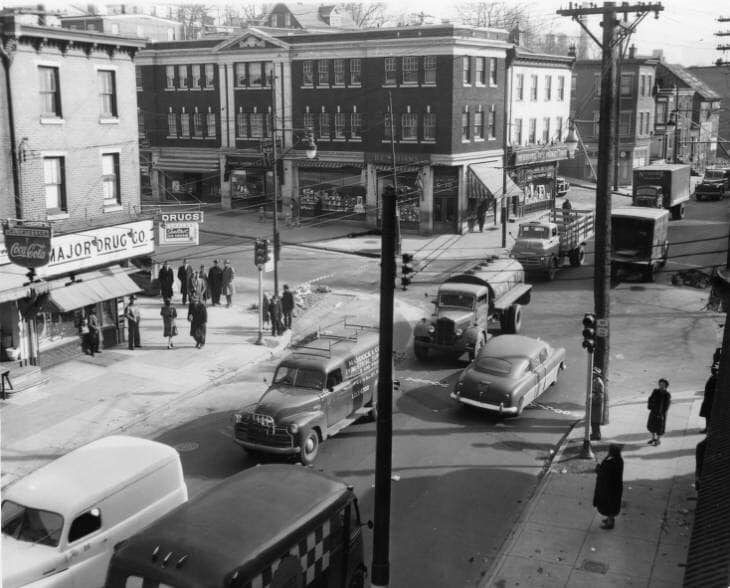
By request, we’re sharing more of Joe Petrone’s vivid memories – this time his favorite stores in East Falls from the 40’s and 50s. Do you remember them?
“We went to Len’s Store at the bottom of Bowman and Cresson Street for clothes. You’d go with five or six dollars and you’d get a brand new pair of Lee’s jeans, a shirt, and a pair of sneakers. With a buzz haircut, you were set for the summer. Len was a really nice, wonderful Jewish man. He took care of the neighborhood. The store, now torn down, was across from the old Italian Club (where Franklin’s is now). He donated it to the East Falls Sports Association. He was a gentleman who kind of looked like Lawrence Welk. He had pepper hair. He never treated you like a kid. You were the customer.
When you left the store after you bought the new sneakers, you’d throw your old sneakers up – that was a rite of passage. There were tons of sneakers on the lines along that street.
Freddie and Felix Herrera’s barber shop on Ridge was next to the Greek restaurant, the Blue Star…every Greek restaurant was called the Blue Star…
Then there was the Old Falls Tavern back off from the street… and the back escape steps from the poolroom – we’d run back out there when the cops came in the front.
The Old Falls Tavern served Chinese food on Friday nights. That’s where I learned to eat shrimp chow mein. Because we were Catholic – you had to have fish cakes – but along came the Chinese who saved us with shrimp chow mein!
We shopped at Gotwol’s butcher store on Conrad Street near Ainslie. You’d go there and buy your meat for the day. The meat would be hanging up in a butcher locker and they had potatoes and onions and all. And toilet paper on the top shelf – to get it, you’d squeeze the handle on a wooden pole to make “claws” to grab it down.
Quinney’s was a bar on the corner of Conrad and Ainslie Streets, near my real estate store. On Friday nights, you could get seafood out the back door – crab cakes and a bag of French fries. Rosie, the owner,would say in her Irish brogue: ”And what can I do for you tonight, lad?” She was lovely! She smelled of the crabcakes and the fries. My mother would send me there for the 25 cents bag of French fries. And I remember the smell of stale beer.
Ladies had to enter the bar using the ladies entrance on the side.
Pete’s Spaghetti House was a bar – Joe Caruso was the bartender for years. Pete Mazzio,the owner, was quite a handsome guy and drove around in a little two-seated Thunderbird convertible.”
East Falls Past – Swimming Holes of Past Years Are Remembered
The Fallser, August 2015, by Wendy Moody
“Swimming Holes of Past Years Are Remembered“, from the Suburban Press, 7/15/1937.
Falls boys, prior to 1900, enjoyed many a good swim at Guckes Pond, which had formerly served as a brewery dam. Every day of school vacation, local boys visited this popular bathing place, which was formed by the water of a small stream dammed up close to the fire-destroyed beer plant of Philip Guckes.
Today, upper Warden Drive covers the site of Guckes Pond, but “the memories will live for life with the lads who learned the natatorial arts at Guckies.” The pond was surrounded by woods – on one side was a grove of trees extending to Midvale Avenue, and on the other a stretch of grass reached School House Lane (Coulter Street didn’t exist).
The swimmers started up the hill from Midvale Avenue, at about the site of Dr. Howard Schaffer’s house at 3475 Midvale, and raced along a path through the woods to see who could be the first in the water. Most of them simply wore a blouse, pants, and a cap, being sans shoes, stockings, and underclothing. Very often, some lad more daring than the others, would dive in, clothes and all. Swimming to the shore, proud of his momentary glory, he would wring out his scanty attire and spread it out on the grass in the sun. By the time he was ready to go home, his clothes would be dry.
Another favorite swimming hole was the Schuylkill River, just below the City Avenue Bridge, familiarly known as “The Tree” because a certain tree extended over the water making an excellent place to tie a rope so bathers could swing into the river.
There was a fly in the ointment, however, for swimming in this “hole.” It was within the confines of Fairmount Park, and in those days bathing in the park was prohibited. The Park police boat, “Rescue,” used to patrol the area. Many times the Park Guards Dan Furman and Patrick Carr would confiscate the clothes of some lad who had been careless enough to leave them unhidden on the bank (the initiated always took the precaution to stow them away in a safe place, foreseeing such an emergency).
The loss of one’s clothing was always a source of worriment, until the law enforcer relented and, after administering a lecture, returned the garments and let the offender off with the promise that he would never swim in the river again. The promises, it is sorrowfully recorded, were seldom remembered.
Other bathing places, prior to 1900, included: Scott’s Dam in the Falls Creek (under the Henry Avenue bridge); Abbot’s Dam near the Dobson’s mansion; the Anderson’s Hollow pond in West Fairmount Park (which boys called “Dead Horse Pond.”); and McKinney’s Quarry along the Wissahickon behind Alden Park Manor.
Later, the city provided safe and more healthful facilities (e.g. the Bathey, Gustine Lake) though they were not considered as enjoyable…
September
East Falls Past – Sandwiches
The Fallser, September 2015, by Ellen Sheehan
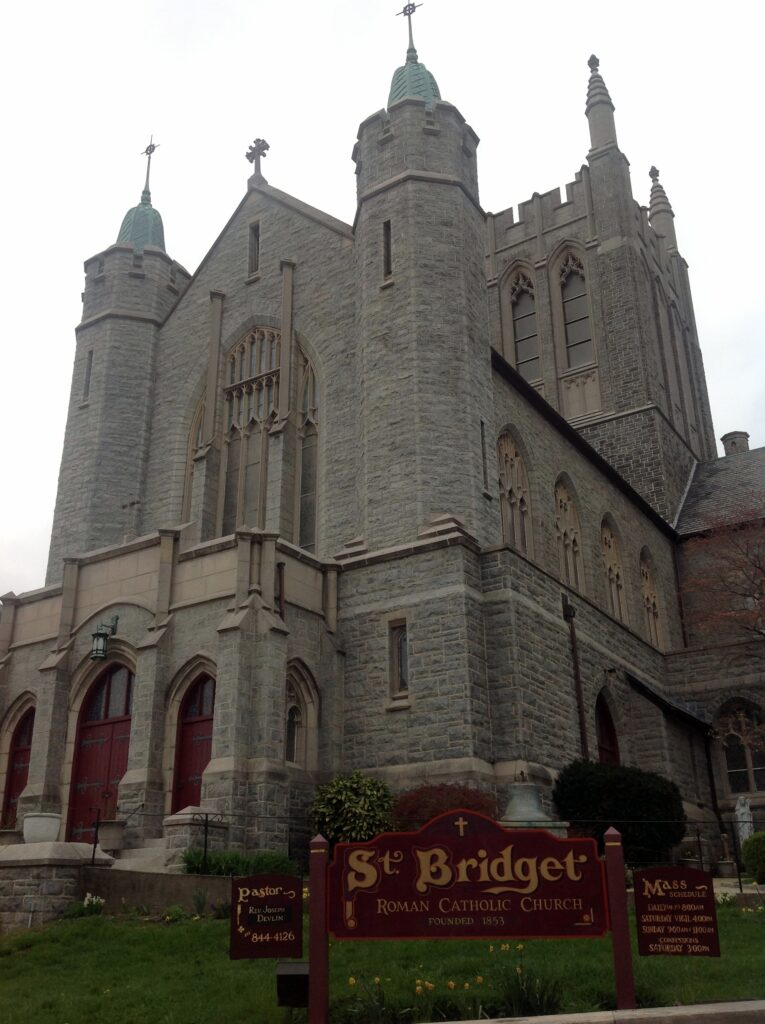
Pope Francis is coming to Philadelphia this month. The name of Francis honors St. Francis of Assisi, the 13th century monk, noted for his devotion to the poor and his love of all of nature. To celebrate the “People’s Pope” in our city, our column this month remembers the history of Sandwich making for the poor here in East Falls for the past 35 plus years.
Four mothers of young children met in each other’s homes in the late 1970’s to make sandwiches for the hungry. Nancy Martin, Lena Dolan, Janet Krimm and Nancy Peacock, rotated as host with the host family providing the meat, bread, mustard and baggies. They took the sandwiches to Sr. Joanne Utz at St. Bridget’s Parish for distribution.
Sr. Joanne sent out an appeal for interested people to make sandwiches in the former EF Post Office, known as Jubilee Hall. The first to respond, Stan Picana, Eileen Flynn, Nancy Sullivan, John Chicci, John Gillespie, Jr. and others, purchased peanut butter and jelly, bread and baggies from the Restaurant Depot with their own money. They made a thousand sandwiches a week. When Jubilee Hall was torn down, the committee moved their enterprise to the school building.
The sandwiches were dispensed to the homeless by Brother Bill McDonnell, an advocate for the homeless in Roxborough and later South Philadelphia, on center city streets until the city objected based on sanitary conditions. Thereafter, the sandwiches are driven by the volunteers to St. Francis Inn, in the Kensington section of the city.
Presently, St. Brendon’s Hall, the former Friary, is home to the committee every Saturday morning from 8:00-10:00 am. The Archdioceses pays for the meat, an anonymous donor pays for the bread to be delivered from the Stroman Bakery, Jeff and Marti Ann Polaski provide the mustard. Baggies and paper towels are donated by parishioners of St. Bridget. A thousand sandwiches are delivered by a volunteer driver to St. Francis Inn without fail every Saturday morning.
Anyone is welcome to participate. Children, Philadelphia University students, all denominations participate whenever they can come. There is no list, no sign in, just the ability to make a sandwich –two pieces of bread, four slices of meat and some mustard put inside a baggie. Coffee, donuts, and friendly conversation are available. Michael Roth, Frank Ashmore and Nancy Laskowski provide the present leadership.
“A little bit of mercy makes the world less cold and more just.” Pope Francis
October
East Falls Past – Interview with Joan Specter
The Fallser, October 2015, by Wendy Moody
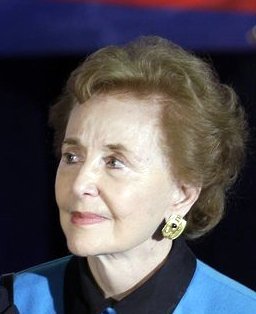
With the national focus on politics in recent months, it seemed timely to share excerpts of an interview Joan Specter, widow of Senator Arlen Specter, gave to the East Falls Historical Society before she moved in 2014. Thanks to Herb Henze for this great interview:
….. We moved to 3417 Warden Drive in 1960 and had one of the steepest hills on the block. The summer was wonderful, but the winter was a hazard trying to get up and down the driveway. But we loved the house and grounds, and had a wonderful time in East Falls. When the children got bigger, we didn’t want to move from here and managed to buy a house on Timber Lane. It’s been delightful – the residents are warm and hospitable to new people on the street.
…. After Arlen finished law school we returned and I taught in the Philadelphia School System. Later, I had a company that manufactured pies that I sold wholesale to restaurants. Then I was elected to City Council. It was too difficult to do both jobs so I sold the business. And gave up apple walnut pie and double chocolate mousse pie…
I’ll tell you a funny story. When my son heard I was selling the business, he called from college and said “Mom, please save me two mousse pies in the basement freezer.” A year later, we had an electrical outage, and when he finally came home, we discovered the pies had melted into a puddle!
…..I was in City Council for 4 terms, 16 years, and survived by keeping my head down! I served under three Council Presidents: George Schwartz, John Street, and Joe Coleman. Joe was good to me and budgeted money when I needed something, like a playground. When you’re At-Large, like I was, it’s a battle to meet all your constituents and visit the various districts and be helpful. It’s a big job.
….. Arlen’s interest was the Middle East. We’ve been to Syria ten times and knew President Hafez al-Assad. It hurt to see the destruction of Aleppo, the second largest city, because we spent much time there. I’m sure the wonderful old fortress has been destroyed. It’s absolutely tragic. All the people who have died, and all the ones who have no home to go back to.
We knew King Hussein in Jordan, and Arlen met Saddam Hussein, who wouldn’t meet women (I stayed in the hotel). We met Gaddafi in a tent in the Libyan desert. In front of it – this was unbelievable – was a fountain spraying water in the desert! Is that crazy?
…..East Falls is a lovely community to walk around – to nod your head at neighbors you don’t know and have them nod back. I’ve always felt safe here. Who can live in such a wonderful place 15 minutes from town? And three different roads to take you there! It’s a convenient, friendly, and beautiful place that has become more beautiful with people planting trees and gardens. It’s quite sad to be leaving.



